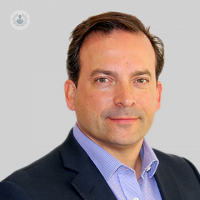An in-depth guide to prostate cancer and its treatment
Autore:Prostate cancer is one of the most common cancers among British men, however, there are several treatments available. In his latest article, renowned consultant urologist Mr Tim Dudderidge explains these treatments in detail, including radiotherapy, surgery and chemotherapy.

What is prostate cancer?
Prostate cancer, like many other cancers, is a malignancy. On the other hand, it is different to many other cancers, as it is slow-growing, and may not be responsible for the death of a patient. However, about 11,000 patients per year will die of prostate cancer in the UK.
Prostate cancer arises in most patients in the peripheral zone of the prostate, which wraps around the bit that is responsible for the enlarging of the prostate, the transition zone. The peripheral zone is like a thick onion skin wrapping around the prostate, and it can be felt. This is why prostate cancers can be diagnosed by finger examination.
They can also be detected through a blood test, called a PSA test. Nowadays, PSA tests or an MRI scan are used as they are much more accurate than finger examination.
How is prostate cancer treated?
Prostate cancer treatment includes monitoring. Monitoring is a management strategy rather than a treatment, but for low-risk disease, monitoring is often the best course of action, as it avoids all of the side effects of treatment, and can identify when the cancer is about to get nasty. Then the doctor can intervene.
If you do need treatment, there are two main categories:
- Focal treatment, which is generally less invasive and only targets the area affected by the cancer.
- Whole-gland treatment, which targets the whole prostate, because it might be a multifocal cancer.
Within the focal treatments, we have multiple different energy sources that can be used. I tend to use high-intensity focused ultrasound or cryotherapy. There are other treatments like laser ablation, and all the treatments are trying to do the same thing: using energy to destroy a targeted bit of prostate.
The whole-gland therapies generally include surgery or radiotherapy. This can either be external radiotherapy or seed-implant brachytherapy. Whole-gland therapy aims to treat all of the prostate cells, both cancerous and benign, and treat the prostate this way.

If we focus for a second on focal therapy, this is only really possible due to the advancements in MRI technology. We then use a biopsy to ensure that the bit we are worried about is cancer, and to confirm that the other areas are free of cancer. Once we have done this, we can begin the treatment. Most of these focal therapies are day case procedures. They don’t require any incisions, but some may require one week of using a catheter. The risk of incontinence is very low. The risk of erectile dysfunction is still a potential risk, but much less of a risk than if surgery or radiotherapy was being performed.
On the other hand, if you need whole gland treatment, surgery with the Da Vinci robot is far better than it used to be and much easier and more precise than doing a laparoscopic approach. For these reasons, it has become the leading choice for operating on the prostate.
Keyhole surgery using the Da Vinci uses six small incisions on the abdomen, with the largest next to the belly button. This is where we remove the prostate, into a bag at the end of the procedure. This operation usually requires the patient to stay in hospital for one or two nights. You would also have a catheter in after the operation for a week. Once this is removed, you will be back to full sporting activity in about 6 weeks.
There are some very small risks of internal bleeding or damage to internal organs after the surgery, but the main risk is temporary urinary incontinence, particularly when you cough, sneeze or laugh. However, this gets better over time. Over half of men will no longer be experiencing socially difficult incontinence three months after the procedure, and a year after the procedure 85 – 90% of men will no longer be experiencing incontinence.
The other risk is erectile dysfunction. This risk is variable and will depend on the procedure that needs to be done. You should talk to your doctor about his risk.
Radiotherapy is another whole-gland therapy. This is delivered by a clinical oncologist. Patients will usually have 3 months of hormone treatment, which takes away the male hormone testosterone. This shrinks the prostate down; and increases the success rate of radiotherapy. Radiotherapy is given over either 20 or 37 visits. Increasingly, urologists are injecting a gel spacer which moves the rectum away from the prostate, reducing the risks of radiotherapy on the bowel.

The risks of radiotherapy are a bit different to surgery. Stress incontinence is not so much of a problem, although it can affect both the bladder and bowel leading to frequent urges to use the toilet. In some cases, you can get leakage from both the bladder and bowel, but thankfully, it’s only in a relatively small proportion of men who undergo radiotherapy.
The side effects of radiotherapy do last a long time and can be with you for life. They can even emerge after many years. There is also a very small increased risk of second cancers after radiotherapy, particularly of the bladder and the bowel.
How does the stage of cancer affect treatment options?
Prostate cancer, like all cancers, will require you to have some tests once it is diagnosed. These tests will show if the cancer has stayed in the gland, or started to spread outside of the gland into neighbouring structures, such as the lymph nodes or the bones.
We call this the process of staging and we use the TNM staging system. When you start the staging, the first question is do you have a localised disease that is suitable for curative treatment?
If this starts to spread into the structures, the success rate of a curative treatment gets lower and lower. We normally are pretty confident about curing T1 and T2 disease. T3 disease might need more than one treatment, as surgery and radiotherapy on their own sometimes are not successful. Once we get to T4, it is very hard to cure the disease, as it involves the rectum or the pelvic floor. It is more likely to need hormonal treatments in addition to local treatments. Once it starts to go into the lymph nodes, we call this N1. This is when the disease has developed the biology to spread. In these situations, you will need treatment for both the prostate and the pelvic lymph nodes. In certain circumstances, this will not be suitable and you will need systemic therapy, which can include chemotherapy, hormone therapy or novel anti-androgen treatments.

Once you have a disease that is in the bones, systemic treatment is the main form of treatment. The stage of the cancer is very important and will determine whether you need local or systemic treatment. For those who have risky features on their biopsy tests, other staging tests like a bone scan or CT scan will be arranged.
Can prostate cancer be cured?
Prostate cancer can be cured, but one of the big questions is: does it need to be cured? Men with low-risk disease may not need curative treatment. It can be monitored and then treated when it requires treatment.
For those who have a localised disease that is still in the prostate or just breaking out of it, curative treatment can definitely be offered, typically in the form of either surgery or radiotherapy. In some cases, focal therapy may be appropriate. Curing the disease is the target for all men. If they are unfortunate to have a disease that has spread, only then do we say the disease is uncurable, but it is something we can control. Thankfully, we can control it for many years.
If prostate cancer is treated, is it likely to recur?
The risk of recurrence after prostate cancer treatment depends on the characteristics of your disease. You should speak to the doctor who is looking after your treatment about whether the disease has high-risk features. After treatment, you need PSA testing to monitor your prostate. In certain circumstances, you may need an MRI or CT scan to monitor for signs of recurrence. For men who have had focal therapy or radiotherapy, you may also need a biopsy to see if the recurrence is coming from the prostate or from somewhere else.

The good news is for men who have had radiotherapy or previous surgery, some treatments can be given. If you’ve had focal therapy, this can even be repeated.
If you have had surgery and the cancer recurs just in the prostate bed, you can have radiotherapy. If you have had previous radiotherapy and the disease comes back, typically surgical removal is quite complicated and comes with risks so it is not a common option. However focal therapy and ablation of the prostate are an option.
If it comes back and spreads to other areas such as the bones, normally hormone treatment will be given, coupled with chemotherapy and an anti-androgen treatment.
Mr Tim Dudderidge is a leading consultant urologist with over 20 years of experience. If you would like to book a consultation with Mr Dudderidge, you can do so today via his Top Doctors profile.


